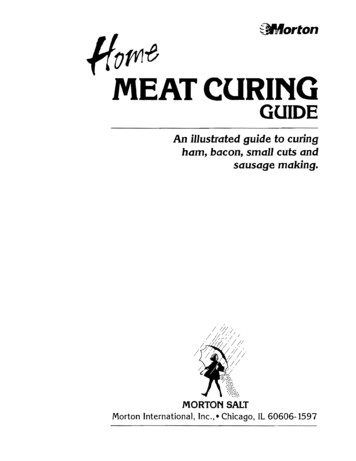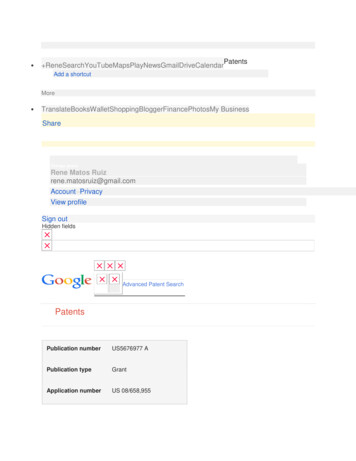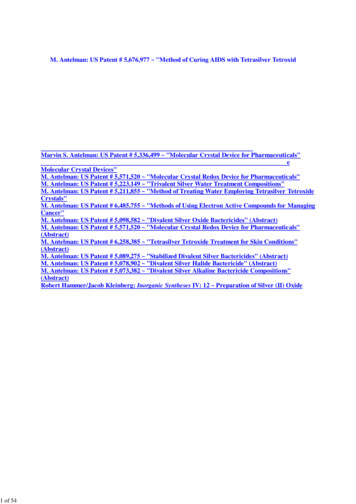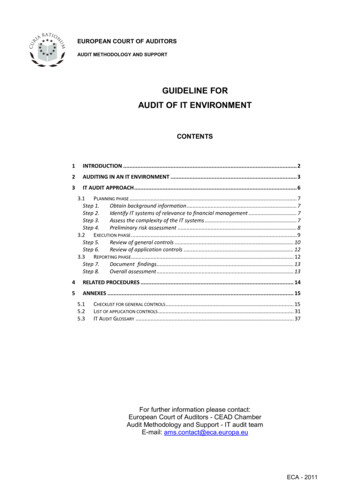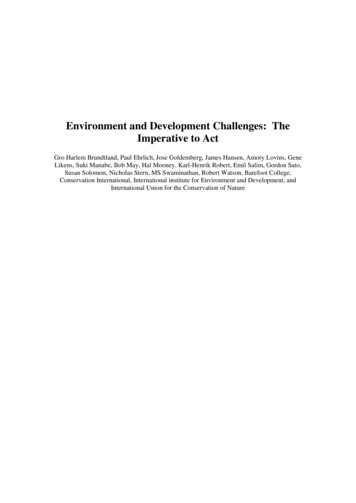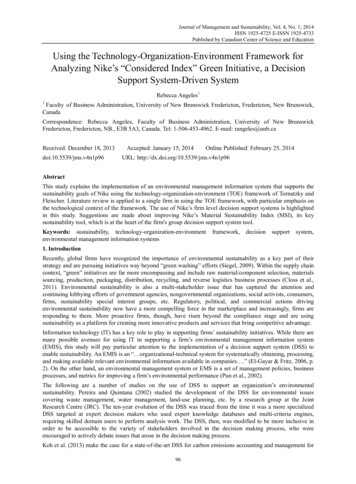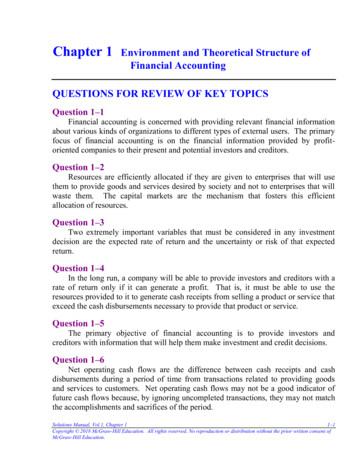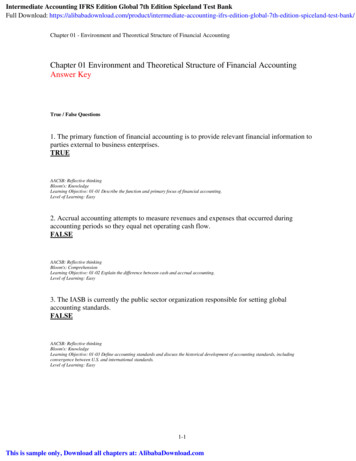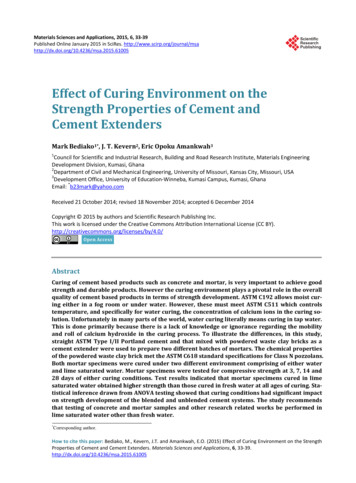
Transcription
Materials Sciences and Applications, 2015, 6, 33-39Published Online January 2015 in SciRes. 10.4236/msa.2015.61005Effect of Curing Environment on theStrength Properties of Cement andCement ExtendersMark Bediako1*, J. T. Kevern2, Eric Opoku Amankwah31Council for Scientific and Industrial Research, Building and Road Research Institute, Materials EngineeringDevelopment Division, Kumasi, Ghana2Department of Civil and Mechanical Engineering, University of Missouri, Kansas City, Missouri, USA3Development Office, University of Education-Winneba, Kumasi Campus, Kumasi, GhanaEmail: *b23mark@yahoo.comReceived 21 October 2014; revised 18 November 2014; accepted 6 December 2014Copyright 2015 by authors and Scientific Research Publishing Inc.This work is licensed under the Creative Commons Attribution International License (CC tractCuring of cement based products such as concrete and mortar, is very important to achieve goodstrength and durable products. However the curing environment plays a pivotal role in the overallquality of cement based products in terms of strength development. ASTM C192 allows moist curing either in a fog room or under water. However, these must meet ASTM C511 which controlstemperature, and specifically for water curing, the concentration of calcium ions in the curing solution. Unfortunately in many parts of the world, water curing literally means curing in tap water.This is done primarily because there is a lack of knowledge or ignorance regarding the mobilityand roll of calcium hydroxide in the curing process. To illustrate the differences, in this study,straight ASTM Type I/II Portland cement and that mixed with powdered waste clay bricks as acement extender were used to prepare two different batches of mortars. The chemical propertiesof the powdered waste clay brick met the ASTM C618 standard specifications for Class N pozzolans.Both mortar specimens were cured under two different environment comprising of either waterand lime saturated water. Mortar specimens were tested for compressive strength at 3, 7, 14 and28 days of either curing conditions. Test results indicated that mortar specimens cured in limesaturated water obtained higher strength than those cured in fresh water at all ages of curing. Statistical inference drawn from ANOVA testing showed that curing conditions had significant impacton strength development of the blended and unblended cement systems. The study recommendsthat testing of concrete and mortar samples and other research related works be performed inlime saturated water other than fresh water.*Corresponding author.How to cite this paper: Bediako, M., Kevern, J.T. and Amankwah, E.O. (2015) Effect of Curing Environment on the StrengthProperties of Cement and Cement Extenders. Materials Sciences and Applications, 6, 33-39.http://dx.doi.org/10.4236/msa.2015.61005
M. Bediako et al.KeywordsCuring, Water, Lime Saturated Water, Mortar, Compressive Strength, ANOVA1. IntroductionSince the introduction of modern Portland cement by Joseph Aspdin, a British mason, in 1824―the material hasundergone series of refinement and now known to be the most commonly utilized binding agent for the formation of concrete and mortar for the global construction industry [1]. Hydraulic cement, also known as Portlandcement, has successfully been used for the construction of major structural works including bridges, pavements,dams, high rise building and residential apartment, etc. Many structures constructed from Portland cementsinceits commercialization in Britain many years ago have survived well with little or no maintenance. The construction industry without cement is tantamount to human beings without air. Currently the global demand forPortland cement stands at approximately 5 billion tonnes as of the end of 2013 [2]. In modern construction,Portland cement usage has seen many modifications. Most notably these modifications aim to achieve optimumcement utilization and economy [3]. Materials usually used to modify cements are referred to as supplementarycementitious materials (SCMs) or cement extenders including pozzolanic and hydraulic materials such as fly ash,silica fume, calcined clay and shales, slags and other filler materials such as limestone, chalk, ripple glass, etc.[4] [5]. The use of supplementary cementitious materials or cement extenders have usually been limited to between 20% and 30% of cement replacement by many reseachers [6]-[9].In many structural constructions, strength properties of mortar and concrete are among the most importantparameters that best describes the quality and structural durability of a project. In many instances, building professionals are paid and rated depending on the strength quality of mortar or concrete. The achievement ofmaximum strength is dependent on the extent of cement hydration. With proper curing cement can more fullyhydrate and achieve maximum strength. In Ghana, many building professionals depend on laboratory controlledpractices to determine the compressive strength of formulated concrete or mortar. A recent survey carried outwithin building professionals and laboratory technicians showed that about 95% of concrete and mortar curing iscarried out in fresh water [10]. This problem is not peculiar to only Ghana but many other African, Asia andSouth American nations. However standardized practices in larger economies such as the United States andChina perform laboratory curing of concrete and mortar in a lime saturated environment usually in accordancewith ASTM C192 [11]. The European standards however are very silent on the type of curing water for concretecubes [12]. Improper curing or lack of adherence to best standard practices could significantly affect strengthproperties of concrete and mortar. Though many factors other than curing affect the development of strength,this work focuses on the effect curing environment has on lab-cured specimens. Lower tested strength resultingfrom improper curing practices skews mixes to higher cementitious material contents which increase not onlythe cost but embodied CO2. There is the need to reconcile the commonly used Ghanaian, and other Africanlaboratory curing practice to that of the developed countries in order not to compromise and misinformed contractors, consultant and owners on the strength properties of cement based products.In this study the main objective was to investigate the effect different curing environment or medium, freshwater and lime saturated water has on the compressive strength of cement based products. In order to prevent thevariability that results from aggregates using concrete, the study scope focused mainly on mortars formulatedfrom cement and an extender comprising of a powdered waste clay brick. The hypotheses for the study were:1) Does water curing environment affect the compressive strength of Portland cement?2) Does water curing environment affect the compressive strength of Portland cement blended binder morethan straight Portland cement?2. Literature ReviewCuring is the maintenance of satisfactory moisture content and temperature in concrete or mortar for a sufficientperiod of time immediately following placement [13]. Curing has a strong influence on hardened cement products (mortar and concrete) by improving strength, volume stability, permeability resistance and durability [14].The methods used for curing involves those that maintain availability of water such as ponding or immersion,34
M. Bediako et al.sprinkling or fogging and covering concrete surface with wet burlap and those that minimize loss of mixing water from concrete including membrane forming compounds, impervious paper or plastic sheets [14]. The importance of these two methods of curing is primarily to help cement achieve more complete hydration.Cement hydration leads to the formation of cement compounds including calcium silicate hydrate (CSH),portlandite (CH), and ettringite (Aft) [15]. Neville [16] has pointed out that when the relative humidity in a mixfalls below 80%, curing ceases. Curing performed in a suitable environment especially at early stages of hardening produces good concrete and mortars because cement becomes fully hydrated. At early ages, CH is an important compound which accelerates cement hydration whilst at later age it contributes to pozzolanic reaction.Low concentrations of Ca2 especially at early hydration stage produces low pozzolanic reactivity hence decreases compressive strength. CH is relatively mobile in the cement paste matrix and can easily be leached out.Dissolution and leaching of CH increases the porosity within the cement system and decrease the pH levelwhich consequently compromise strength and durability of cement based products [17] [18]. The pH level incement and cement extenders during hydration and pozzolanic reaction is very vital for the dissolution of pozzolanic materials and reformation of additional CSH. In circumstances where improper curing contributes toleaching of CH, there is usually a reduction in compressive strength of concrete or mortar.Curing of specimens in the laboratory is usually different from concrete placed during construction. TheASTM specification has developed standards for each, ASTM C192 [11] and ASTM C31 [19]. The ASTM C192[11] isutilized for laboratory curing whereas the ASTM C31 [19] is used for field samples. Zemajtis [20] mentions that variations in standard curing of test specimen can dramatically affect measured concrete properties.However, this basic knowledge is not commonly understood in many developing countries and may result inover-cemented mixtures.3. Materials and Methods3.1. MaterialsThe materials used for the study were ASTM Type I/II cement, powdered waste clay brick (PWCB), calciumhydroxide, potable water, polycarboxylated high-range water reducer, and sand. The cement was Ashgrove fromChanute, Kansas City, Missouri. PWCB was obtained from Council for Scientific and Industrial Research-BRRIbrick factory in Ashanti Region, Ghana. The sand used for the study was a graded silica sand and conformed tothe ASTM C778 [21]. The water reducer was BASF Glenium 7500. Table 1 presents the physical and chemicalproperties of the ASTM Type I cement and PWCB. The PWCB contains main oxides, SiO2, Al2O3 and Fe2O3 at89.9% satisfying the ASTM class N pozzolan recommended in the ASTM C618 standard specifications [22].Table 1. Physical and chemical properties of ASTM type 1cement and PWC.PropertyASTM Type I/IIPWCBFineness (m2/kg)401.7410.5specific gravity3.132.45SiO2 (%)20.4967.35Al2O3 (%)4.2614.70Fe2O3 (%)3.147.83CaO (%)63.482.19MgO (%)2.111.67SO3 (%)2.90.15Na2O K2O (%)0.491.21LOI (%)2.24.01PhysicalChemical35
M. Bediako et al.3.2. MethodsMortar Preparation, Mixing and CuringThe mortars were prepared in accordance with the ASTM C109 [23]. The method specifies sand to cement ratioof 2.75 while maintaining a water-to-cement ratio at 0.485. Two batches of mortar specimens were preparedwhich included those cured in saturated lime water and those cured in fresh water. PWCB was pulverized to 75microns and blended with Portland cement to form a binder for another batch of mortar formation. The waterreducer (HRWR), Glenium 7500 was added to mortar mix containing PWCB to maintain a flow between 105and 115% as determined by ASTM C1437 [24]. Addition of 30% PWCB to 70% of cement produced a stiffermix hence the need for a superplasticizer to improve workability of the mortar mix. Table 2 shows the mortarmixture proportion of the control (CONT) and the Portland cement blend containing 30% waste clay brickpowder (PWCB). The mixture proportions were used to prepare six mortar specimen per batch. Specimens werecast in 50 mm cubic metallic molds and allowed to set for 24 hrs at a temperature of 23 C, covered with a plasticsheet and a wet burlap to prevent evaporation. The specimens were demolded after 24 hrs and samples cured intwo separate environments of fresh water and lime saturated water for 3, 7, 14 and 28 days. Compressivestrength is reported on an average of three samples.Inferential statistical analysis was performed using analysis of variance (ANOVA) on the two separate batchesof mortars cured under the two different environment for 3, 7, 14 and 28 days. The hypothesis made for theANOVA test was as follows:µ µ µ4Ho: µ 123Ha: µ1 µ2 µ3 µ4where Ho and Ha represent the hypothesis and alternative hypothesis whereas µ1 and µ2 represent the mean values of water and lime curing respectively. The ANOVA test was performed at a 95% confidence level.4. Results and DiscussionsTable 3 presents the compressive strength of the control (CONT) and Portland blended cement labeled asPWCB cured in water and lime saturated water. All mortar specimens cured in lime solution generally acquiredgreater strength than those cured in water solution at all curing periods. For the control mortars, the percentageincrease of lime curing over water curing was between 0% and 19% whereas that of PWCB was between 21%and 66%.Table 2. Mortar mix proportion.Mass (g)Mix nameFlow B35015013752432.7107Table 3. Compressive strength of CONT and PWCB in different curing environments.CONTPWCBCuring mediumCuring time (days)3d7d14 d28 d3d7d14 d28 dWater 1&1%0%Lime water 8%1%7%% increase7%0%9%19%36%21%26%27%NB: COV-coefficient of variance.36
M. Bediako et al.Figure 1 and Figure 2 show the curing trend of CONT and PWCB against compressive strength at differentcuring times. Both figures indicated that strength gain was proportional to curing period irrespective of the curing medium. This is because hydration products that contribute to strength are formed as curing progress.Table 4 and Table 5 show the ANOVA results for both mortars respective
The mortars were prepared in accordance with the ASTM C109 [23]. The method specifies sand to cement ratio of 2.75 while maintaining a water-to-cement ratio at 0.485. Two batches of mortar specimens were prepared which included those cured in saturated lime water and those cured in fresh water. PWCB was pulverized to 75 microns and blended with Portland cement to form a binder for another .
